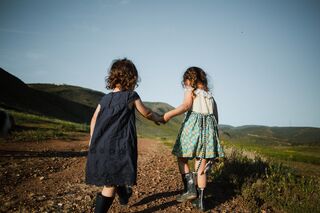Fear
Trapped Inside a Cage of Fear
Why it's hard for today's children to go outside and play.
Posted August 21, 2022 Reviewed by Gary Drevitch
Key points
- The everyday lives of many kids today are sedentary, unadventurous, and risk-free.
- Time outdoors is limited and, when it occurs, carefully regulated.
- Indoors, behind their screens, is often where children actually prefer to be, limiting their own physical and emotional development.

I've heard children say that they feel their safest and happiest at home, in their bedrooms, under the duvet with their digital devices in their hands. The social and emotional challenges facing them outside of their safe-house cages can be frightening. The outside world of other kids, sport, games, nature, activity and all that life offers is not without its real-life dangers. In certain communities, crime is such a problem that kids are in fact not safe outside their houses. The Covid-19 pandemic and its lockdowns exacerbated the trend of kids staying indoors; that was a necessary but concerning retreat behind walls into safety.
Security walls
David Frye, in his book, Walls: A History of Civilisation in Blood and Brick, writes that walls might indeed provide security for the frightened, educated people inside them. However, the personal costs of building walls to protect against the dangerous "barbarians" outside include the loss of much-needed freedom. Added to this is an ever-weakening mind and body that seems to spiral into further fears. With regards to modern children, walls are often necessary but problematic. They can sometimes protect children from threats such as Covid-19, criminals, child molesters, poisonous snakes, social stress, and the harmful rays of the sun. But they prevent kids from facing everyday challenges that bring not only risks but also joy and unbridled opportunities for growth and adventure.
Most parents that I talk to are concerned about the sedentary, indoor, digital lifestyle in which their children seem trapped. They are faced with constant battles to get their children off their screens and into nature. But the outdoors is not always highly valued by children. Many want to be on their screens more than they want to be outside playing. Children themselves are rejecting childhood. Most parents, teachers, and therapists to whom I speak about this recognise that something about childhood has been lost.
Independence and safety
Today’s children seem often to be overly tied to their homes, and sometimes to their parents as well. The bonds of attachment between parents and children are there to keep children emotionally and physically safe. But another vital task for parents is to guide children into independence in age-appropriate ways—and independence often involves leaving the house. Children and teenagers need to step out of the safety of their own homes and to step away from their parents, little by little. They need a certain amount of freedom to do this. But the outside world in some places is just not safe enough, resulting sometimes in very little freedom. Conscientious, involved, and attentive parents might be especially attuned to the threats facing their kids; it's hard not to be over-protective and over-vigilant in a world that can be dangerous.
The relative safety of the particular environment in which a child is being raised, alongside the anxiety levels of the parents, determines to some extent the level of freedom they are allowed. In higher socio-economic areas, children are dropped off at malls and sports fields. A few decades ago, those children might have been allowed to ride their bikes in the street or walk to one another’s houses, further away than what they would be allowed today.
Privileged children from high-income families often play in lovely spaces behind high walls with electric fences and security guards. The ever-present fear of intruders, highjackers, child molesters, thieves, and kidnappers stops some parents from allowing children outside of these prison walls. So kids are driven from one extramural to another, remaining dependent on their parents instead of exploring the wider world and, sometimes, encountering danger and risk.
Weakening minds and bodies
For some children, the pandemic exacerbated and legitimised an already sedentary lifestyle. Lockdowns confined them to their houses and made it impossible to run around outside, either formally at sport or informally in play. Online schooling meant that some kids hardly left their bedrooms. Even worse, many children have been reluctant to let go of the online schooling experience even now that lockdowns have mostly been lifted. Physical immobility leading to developmental delays can be addressed with physiotherapy. But most therapists are aware that alongside their treatment, children with gross motor problems would benefit substantially from riding a bicycle, swimming, walking up and down hills, playing outside, climbing, running, and playing sport. None of these are easy or comfortable and all carry risks.
Today’s child is often confronted with a different kind of risk, linked to being highly regulated and restricted. For some, the boundary wall of their own property is the limit of their independence. Parents keep their children entertained by buying expensive electronic games and other equipment. It is not unusual for children and teenagers to be alone at home behind a screen for hours every afternoon after school. At the end of a long, empty, lonely afternoon at home, they are bored, unmotivated, irritable, and frustrated. Mentally and physically, they haven't faced — and survived — various kinds of discomfort, challenges, and threats in the outside world. And they have not grown any stronger. A healthy, strong, and fit body and mind develop over time through lived experience, not through retreating behind walls of fear.
References
Louv, Richard. Last Child in the Woods: Saving Our Children from Nature-Deficit Disorder. New York: Algonquin Books of Chapel Hill, 2005.
Frye, David. Walls: A History of Civilization in Blood and Brick. London: Faber & Faber, 2018.


